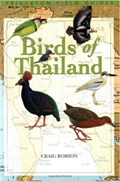| Doi
Chiang Dao National Park |
| Introduction |
| Doi
Chiang Dao National Park, in Chiang Mai province, is Thailand's
third highest mountain at 2220 metres and, viewed from Chiang Dao
village, is one of the most spectacular sights in the whole country.
|
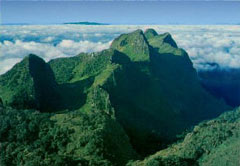
Doi Chiang
Dao
(Photo courtesy of Jurgen
Beckers) |
|
This
limestone massif has a number of peaks and ridges over 2000
metres in a horseshoe shape and has a series of forest types
that change with altitude. The variety of forest types
and altitude of the mountain combined with its close proximity
to Myanmar result in a large number of exciting birds found
here as well as some excellent views and a relaxing atmosphere.
The forests
of Doi Chiang Dao are very intact, although there is a small
hilltribe population in one corner of the park, but most of
this area is too steep for it to come under much threat. Periodically
the Thai government come up with plans to build a cable car
to the summit, but currently this appears to be forgotten
- thankfully! |
|
|
About
Google adverts |
| Birding
Highlights |
| Two
species are the main target birds for most birders here: Giant
Nuthatch and Hume's Pheasant. Both of these occur around the
higher areas of the National Park where they are regularly
seen. Another highly sought-after bird which seems to be fairly
regularly encountered at the higher altitudes is Scaly Thrush.
Be careful not to mistake female Chestnut-bellied Rock Thrush
(which is quite common) for this species to which it bears
a passing resemblance, especially if not seen well.
Grey-headed
Parrotbill, Crested Finchbill, various Thrushes and Black-tailed
Crake are other memorable birds that have been seen higher
up the mountain. |
|
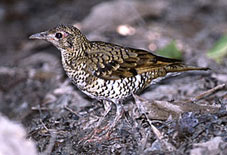
Scaly (White's)
Thrush
(Photo by Suppalak
Klabdee) |
|
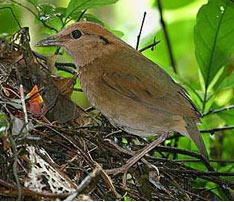
Rusty-naped
Pitta
(Photo by Suppalak
Klabdee) |
|
The
lower levels of Doi Chiang Dao offer the opportunity to see
a different set of forest birds and some open country species.
In the "spring" months Streaked Wren Babbler is
easily spotted near the temple, around the limestone outcrops.
Don't confuse this with the similar looking calcicola
subspecies of Limestone Wren Babbler which is only found in
the region of Saraburi province.
In
the gullies and damp patches around the base of the Chiang
Dao massif, secretive species such as Slaty-bellied Tesia,
Scaly-breasted Partridge, White-crowned Forktail, Hooded Pitta
and Rusty-naped Pitta can be discovered with patience.
If
birders spend time at the top of the mountain, around the
bottom and visit some of the farmed areas, then a very high
number of species will be seen. |
|
| Click
here for a checklist of the birds of Doi
Chiang Dao |

|
|
Bird
Tours : Check the suggested itineraries for
ideas on creating a tailor-made birdwatching trip to Thailand:
Thailand
bird tours. |
|
|
| Travel
Information |
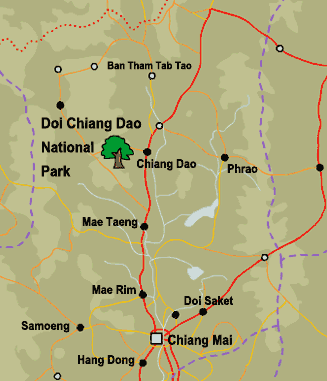
|
|
Getting
to Doi Chiang Dao is fairly easy if coming from the north
or south. Most people arrive in Chiang Mai by bus from Bangkok's
Mor Chit terminal, but look out for good deals on flights
from Bangkok and I'm told the train is a pleasant if rather
slow option. The bus journey takes about 9-10 hours, the train
takes about 17 hours and the plane takes about 45 minutes.
From Chiang
Mai take a bus from the Chang Puek (Albino elephant) bus station
to TaTorn; these leave about once every hour. Tell the conductor
that you will get off at Chiang Dao and he will tell you when
to get off: the journey takes about 2.5 hours. In Chiang Dao
walk northwards along the road to the junction for Chiang
Dao cave which is signposted in English and wait for a motorcycle
taxi. Sometimes one has to wait for 15-20 minutes for the
motorcycle but I do not suggest walking as it is about 5 Kms;
not that far, but in the heat it is a long way. When
a motorcycle taxi turns up simply tell the driver Malee's
or Chiang Dao Nest, whichever you have chosen, and the driver
will take you there.
If coming
from the north it is a simple affair to catch the same bus
from TaTorn to Chiang Mai getting off at Chiang Dao. The bus
terminal in TaTorn is on the south side of the river. The
journey from TaTorn to Chiang Dao takes about 3 hours. |
|
Whilst
staying at Doi Chiang Dao most birders want to take a trip
to Den Ya Kat near the summit for the high altitude birds
and this can be tricky. First one must get a permit to drive
to DYK at park headquarters near Malee's; this is a simple
affair. Then drive back to Chiang Dao (where there is a petrol
station) and turn south towards Chiang Mai. After precisely
4.9 Kms there is a sign which says "checkpoint 20 Km"
which has replaced the former green-roofed bus shelter landmark.
A series of roads on the right all go towards the dirt track
that heads up the mountain and one must simply twist and turn
through the maze of roads until they funnel into one. Once
this turns into a dirt track the quality deteriorates rapidly.
If there has been wet weather the track is very hazardous
and a 4-wheel drive vehicle is a must. In the dry season a
regular vehicle may be sufficient - maybe not: click
here for details of a trip here in 2002.
There
is now a Chiang Dao by-pass which makes finding Malee's a
little confusing. The above instructions are still the best
way to find Malee's and Den Ya Kat. One will cross the highway
when travelling to and from Chiang Dao. |
|
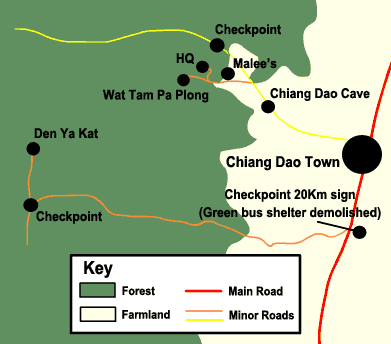
|
|
|
About
Google adverts |
| Finding
Birds |
There
rarely seems to be a shortage of birds at Doi Chiang Dao and with
two roads to high altitude there are plenty of opportunities to
find them. The higher altitudes are where winter specialities such
as Thrushes occur as well as resident Giant Nuthatch and Hume's
Pheasant.
The lower altitudes
play host to large numbers of common forest birds and the gulleys
play host to exciting birds such as Rusty-naped Pitta, Hooded Pitta
and Tesias. In April and May Streaked Wren Babbler is particularly
common at Wat Tam Pa Plong.
A number of
trails are well-known for certain species: |
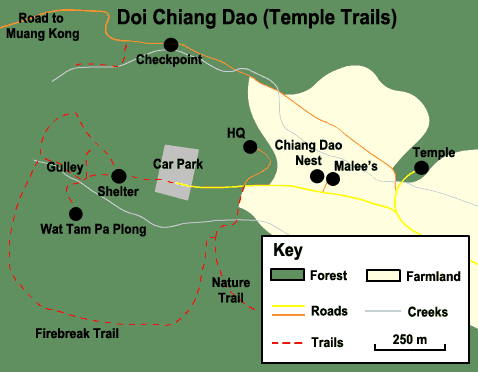
|
| Malee's
and Chiang Dao Nest : There
are many open-country birds to be found in the farmland around these
two resorts. Crested Treeswift is a common sight, soaring overhead
and a number of different Barbets can be found calling from the
many large trees here. It is worth scanning through the grassy areas
for Yellow-eyed Babbler, Asian Stubtail and Yellow-streaked Warbler,
all of which are rather infrequently recorded in Thailand but regularly
sighted here.
Nature
Trail :
This trail goes through a lot of bamboo forest and commences at
Chiang Dao cave. Although not one of the best trails at Chiang Dao
it does provide an opportunity to get within a territory regularly
held by Oriental Hobby. |
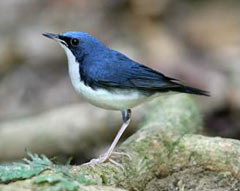
Siberian
Blue Robin
(Photo by Suppalak
Klabdee)
m |
|
Temple
Gulley : This
is one of the most anticipated trails at Chiang Dao. In reality
it is very narrow with thick vegetation and it is difficult
to get good views of birds here. There are, however, a few places
where views become unobstructed so the best policy is to wait
at these until birds come along. There are undoubtedly a number
of great birds that are often seen along here; Hooded and Rusty-naped
Pittas occur but are tricky to see. Slaty-bellied Tesia is sometimes
found here, but White-crowned Forktail, Siberian Blue Robin,
White-throated Fantail and Streaked Wren Babbler are far easier
to find. One has to clamber along the creek bed to negotiate
this trail so it is well worth having a decent pair of boots
to ensure against slipping on wet rocks. The trail supposedly
continues beyond the water tanks which seem to be the trail's
end, but I would not suggest this to any but the most athletic
birders! |
|
Firebreak
Trail : This
firebreak around the temple grounds provides an opportunity to get
into the forest but is not the easiest to negotiate. I would not
recommend it at all after rain as it would be very slippery. Rusty-naped
Pitta is apparently a regular along here and Hodgson's Frogmouth
has been heard.
Wat
Tam Pa Plong : The
easily accessed car park and steps to the temple are a great place
to get to grips with all of the more common birds to be found here.
There are some fruiting trees at the furthest point into the temple
where lots of Drongos, Orioles, Bluebirds and Green Pigeons feed.
The limestone around the monk's quarters are often a good place
to see Streaked Wren Babbler and Speckled Piculet can often be located
from its noisy drumming. Spending time in the temple grounds is
a good way to see a high number of bird species in a short space
of time.
Checkpoint
Gulley :
This gulley is accessible by a trail which begins a short distance
beyond the checkpoint on the Muang Kong road. The vegetation is
more open than at temple gulley so that birds are more easily seen.
The species occurring here are similar to those at the temple gulley
and it is here that most sightings of Tesias occur, including Grey-bellied
as well as Slaty-bellied Tesia.
Road
to Muang Kong :
This road is an excellent location for birding and rises to a considerable
altitude giving an opportunity to see some of the birds that do
not occur lower down the mountain. Birds such as Long-tailed Minivet,
Orange-bellied Leafbird and White-browed Shrike Babbler are commonplace
higher up and other treats that I have seen along this road are
Oriental Hobby, Pin-tailed Pigeon and Hodgson's Hawk Cuckoo. There
is a summit trail from one of the highest points along this road
and although the top is still a long way from the start this trail
should offer some good birding opportunities. |
|
Firebreak Trail (DYK) :
About
1 kilometre before arriving at Den Ya Kat substation there
is a sharp turn to the right and here there is a nice trail
up a ridge along a firebreak. This trail is straight ahead
as one drives towards the sharp right hand turn. There are
many pine trees up here and there have been numerous sightings
of Hume's Pheasant early in the morning as it crosses the
firebreak. Other birds along this trail are Chestnut-bellied
Rock Thrush, Grey Treepie, Eurasian Jay and Rufous-gorgetted
Flycatcher which seems unusually common here.
Summit
Trail : This
trail starts to the left of the substation, going through
some grassland and then along some ridges. Quite a number
of good birds can be seen along here, including Stripe-breasted
Woodpecker, Hume's Pheasant and, of course, Giant Nuthatch
which is reliably seen at the point marked, but naturally
should be looked for all along this trail. In the grass quite
a number of Bush Warblers skulk, but I've never seen any long
enough to identify them; perhaps with the aid of a tape they
could be lured out into the open. A small pond at the substation
is reputed to be the home of Black-tailed Crake but it would
be vital to spend the night here in order to see it, but plenty
of other birds including Thrushes and Parrotbills can be seen
on a day trip.
Birding
Road : Once
past the checkpoint the access road becomes a birding location
in itself. Giant Nuthatch is often seen along here and Hume's
Pheasant is sometimes seen running across the road - try not
to run it over! There are plenty of places to stop the car
and lots of good habitat where anything could turn up.
m |
|
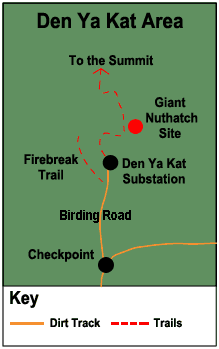
|
|
Rice
paddies
:
I've been receiving some good records of open-country species from
rice paddies a little south of Chiang Dao town. Information is located
here: Chiang
Dao rice paddies. |
| Facilities |
|
About
Google adverts |
| For
a long time now birders have stayed at Malee's Nature Lovers Bungalows
a few kilometres beyond Chiang Dao cave. Malee's set-up is very
quaint, with some excellent views of the mountains; indeed, many
people have been content to spend a day birding in the garden, with
some excellent species having been recorded.
There
are now 9 bungalows here to rent here, set in a very attractive
garden, at rates from 500-1100 baht per night, all with private,
hot showers; Malee usually gives a slightly better rate to returning
guests. The old dormitory room has been converted into 4 small rooms
at 250 baht per night, with a shared hot shower and toilet. All
rooms are equipped with fans, although at times it can be chilly
at night. |
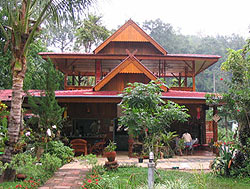
Malee's
rooftop restaurant
(Photo by Malee Keratitaweesuk) |
|
Malee
now has a rooftop restaurant, which is really nice, making
full use of the great views here. Dinner is served around
7 pm but this is flexible , so that birders wishing to stay
out late to look for Owls and Frogmouths are able to do so.
Packed breakfasts and lunch are also available for those wishing
to get out early and stay out all day, particularly if travelling
to Den Ya Kat. Malee can arrange for a four-wheel drive vehicle
and driver up to Den Ya Kat for 1500 baht, something I would
recommend if the weather has been wet as the road up Doi Chiang
Dao can be a treacherous mudslide. She can be contacted by
e-mail maleenature@hotmail.com
to book accommodation which might be necessary during the
dry season and at weekends, otherwise just turn up. For those
without their own transport Malee can arrange for pickup from
Chiang Mai and the airport; a very convenient alternative
to public transport! Doug Judell started a bird log at Malee's
some years ago and it continues to be a good source of information.
Malee has high speed internet available, so please send me
your notable observations. |
|
| For
a few years now there has been another bungalow resort right
next to Malee's, called Chiang Dao Nest, and an increasing number
of birders stay there. A number of bamboo huts are for rent
here and food is served to order, as late as 9 pm, for those
who want to stay out and spotlight birds; a very extensive and
unusual selection of Thai and Western food is available. I understand
that breakfast is available at very early times and packed lunches
can be arranged. This is an extremely relaxing place, with lovely
views and the management is friendly. If arriving by public
transport a trip to Den Ya Kat can also be arranged at this
resort. See their website for details about this excursion and
to contact Chiang
Dao Nest. There is a birding logbook here too.
Chiang Dao Nest also has a second location, Chiang Dao Nest
2 which is a few hundred metres from back towards the cave from
Chiang Dao Nest 1. Free internet and free wireless internet
is available. |
|
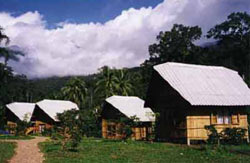
Chiang Dao
Nest 1
(Photo courtesy of Chiang
Dao Nest) |
|
At
Chiang Dao cave there are a number of restaurants that sell good
food for low prices and touristy things like film for cameras, postcards
and souvenirs.
For those that
wish to camp at Den Ya Kat there are very few facilities, just a
lawn for your tent and toilets, so take everything you need with
you, although for those who smile and look desperate enough the
guards will probably sort out some alternative accommodation and
food.
For the really
adventurous it is possible to arrange porters to carry all your
equipment to the top of Doi Chiang Dao for a camping trip - everything
must be taken in and out as there are no facilities at all there,
although there must be some good birds.
The entrance
fee here is 200 baht and must only be paid if driving to Den Ya
Kat substation and is valid for a few days. All other areas can
be accessed without paying, although some people have been asked
for their ticket when driving the Muang Kong road - keep your ticket
from your trip to Den Ya Kat and show it - it will be sufficient. |
 |
| Donations |
If
you found this page useful, please consider making a donation.
|
| Other
Related Pages |
Birdwatching
Tours/Guiding
Other
Northern Thailand Birding Locations
Chiang
Dao Paddies
Rice
Paddies Near Chiang Dao
Current
Entry Fees for National Parks
Air
Pollution in Chiang Mai |
| Photo
Galleries |
|
| Trip
Reports |
| |
| Related
Blog Entries |
Silver-eared
Mesia - posted 11/01/09
Tour
of Thailand, 17 January to 6 February 2008 -
posted 05/03/08 |
| Tags |
| birds,
birding,
thailand,
nature, national
parks |

